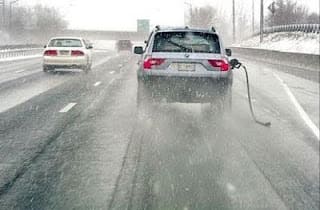 Remember KIT from the TV series Knight Rider?
Remember KIT from the TV series Knight Rider?
Well, just when we think Google has run out of surprises, we learn from John Markoff at The New York Times that a small team of Google engineers has been quietly running robots on our highways. Not just one or two robots sneaking a few miles down a lonely country road late at night, but eight autonomous vehicles traveling more than 140,000 miles in the last year on everything from freeways to traffic-clogged downtown districts. Google’s car-bots have confidently traversed roads that would leave many drivers white-knuckled, from San Francisco’s pretzel-twisty Lombard Street to Big Sur’s narrow, cliff-hugging Highway One.
Sebastian Thrun and his Google Team have accomplished something that even the most optimistic experts in the field thought was five to 10 years off. Little wonder that Thrun’s team jokingly refers to the effort as their “Drive-thru Manhattan Project.”
Before word of Google’s robot surprise, the consensus among researchers was that autonomous robotic cars would not be commonplace on our highways for at least two decades. That number will now have to be revised downward, but it would be a mistake to expect robocars to start appearing in auto showrooms any time soon. Barriers range from regulatory anxieties to the auto industry’s famously conservative engineering culture, and more than a few daunting technical challenges. The good news is that near-robotic vehicles are just around the corner and they are guaranteed to deliver more than their share of surprise along with some very tangible benefits. Here are a few developments that I think are especially likely in the near future:
Cruise control on steroids
Better sensors and artificial intelligence will deliver adaptive cruise control capable of responding to sudden slowdowns and anticipating fog-hidden pileups. These systems will link to data in the cloud (like Google Maps and Street View) to provide smart real-time hazard identification, routing and warnings when drivers are speeding above posted limits. Our cars will chide us if we tailgate and watch us as we drive and jolt us awake if are distracted or drifting off to sleep.
We can already buy cars that parallel park, but Sebastian’s team overcame an even greater challenge, teaching their car-bots to merge into freeway traffic. Merging is a social activity that combines manners with Newtonian physics at 60 mph at a point typically located in a driver’s blind spot. Anyone who has been cut off by some jerk refusing to let them in, or tripped up by an over-polite driver slowing down to make space, knows just how complex this problem is. Google’s car-bots have perfect peripheral vision, software that reads the body language of the other cars and most importantly, no ego.
Robotic convoys
Imagine a military convoy comprised of a single human-controlled lead vehicle and a line of unmanned autonomous supply vehicles obediently following behind like a line elephants in a circus.
Car-sharing becomes practical
Why buy a car when you can subscribe to one? Sebastian Thrun even thinks we can create a service where instead of picking up your car in a nearby parking space, the driverless car will come to you like a well-trained spaniel.
We want to say thank you to one of our customers, Ray S., who lead us to this piece by Paul Saffo – of which we liberally used for this article.